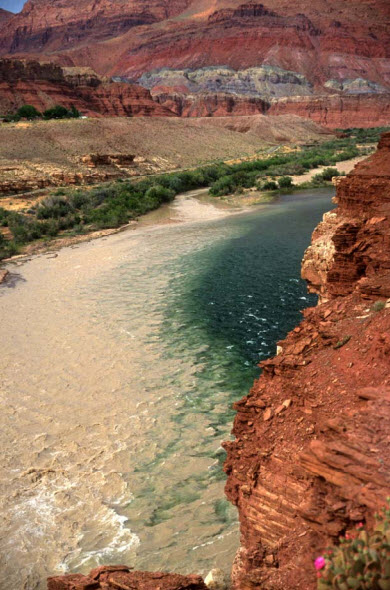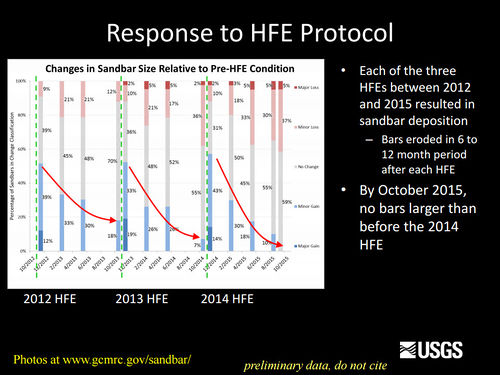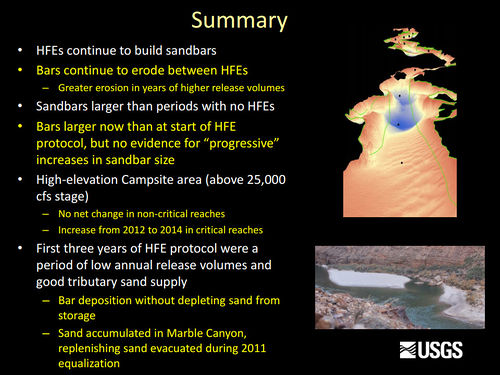Difference between revisions of "GCDAMP Sediment"
Cellsworth (Talk | contribs) |
Cellsworth (Talk | contribs) |
||
| Line 116: | Line 116: | ||
'''2016''' | '''2016''' | ||
| + | *[https://pubs.er.usgs.gov/publication/pp1823 Topping et al. 2016. Long-term continuous acoustical suspended-sediment measurements in rivers — Theory, application, bias, and error: U.S. Geological Survey Professional Paper 1823, 98 p.] | ||
*[http://pubs.usgs.gov/fs/2016/3053/fs20163053.pdf Voichick et al. 2016. Water clarity of the Colorado River—Implications for food webs and fish communities: U.S. Geological Survey Fact Sheet 2016–3053, 4 p.] | *[http://pubs.usgs.gov/fs/2016/3053/fs20163053.pdf Voichick et al. 2016. Water clarity of the Colorado River—Implications for food webs and fish communities: U.S. Geological Survey Fact Sheet 2016–3053, 4 p.] | ||
*[http://www.usbr.gov/uc/rm/amp/amwg/mtgs/16aug24/Attach_11a.pdf Sandbar Modeling Project Update] | *[http://www.usbr.gov/uc/rm/amp/amwg/mtgs/16aug24/Attach_11a.pdf Sandbar Modeling Project Update] | ||
*[http://www.usbr.gov/uc/rm/amp/amwg/mtgs/16aug24/Attach_07b.pdf Status of Sediment Resources – August 2016] | *[http://www.usbr.gov/uc/rm/amp/amwg/mtgs/16aug24/Attach_07b.pdf Status of Sediment Resources – August 2016] | ||
*[http://www.usbr.gov/uc/rm/amp/amwg/mtgs/16aug24/Attach_07a.pdf Grand Canyon Monitoring and Research Center Science Updates and PPT (BO Compliance, Trout Updates, Green Sunfish, Fisheries PEP, Partners in Science)] | *[http://www.usbr.gov/uc/rm/amp/amwg/mtgs/16aug24/Attach_07a.pdf Grand Canyon Monitoring and Research Center Science Updates and PPT (BO Compliance, Trout Updates, Green Sunfish, Fisheries PEP, Partners in Science)] | ||
| − | |||
*[http://www.usbr.gov/uc/rm/amp/twg/mtgs/16jan26/documents/AR03_Buscombe.pdf Observations of sand dune migration on the Colorado River in Grand Canyon using high-resolution multibeam bathymetry] | *[http://www.usbr.gov/uc/rm/amp/twg/mtgs/16jan26/documents/AR03_Buscombe.pdf Observations of sand dune migration on the Colorado River in Grand Canyon using high-resolution multibeam bathymetry] | ||
*[http://www.usbr.gov/uc/rm/amp/twg/mtgs/16jan26/documents/AR01_Topping.pdf Project 2: Streamflow, Water Quality, Sediment Transport, and Sand Budgets in the Colorado River Ecosystem] | *[http://www.usbr.gov/uc/rm/amp/twg/mtgs/16jan26/documents/AR01_Topping.pdf Project 2: Streamflow, Water Quality, Sediment Transport, and Sand Budgets in the Colorado River Ecosystem] | ||
| Line 126: | Line 126: | ||
'''2015''' | '''2015''' | ||
| + | *[https://eos.org/features/building-sandbars-in-the-grand-canyon Grams et al. 2015. Building Sandbars in the Grand Canyon, EOS, Trans. Am. Geophys. Union, 96(11), 12–16. ] | ||
| + | *[http://repository.asu.edu/items/30069 Alvarez. 2015. Turbulence, Sediment Transport, Erosion, and Sandbar Beach Failure Processes in Grand Canyon. Ph.D. Dissertation, Arizona State University, Tempe, AZ, 176pp.] | ||
*[https://drive.google.com/file/d/0BwY-Z2c3NTUGeUVIWEwyY1l6RUE/view GCMRC Science Update - Sediment] | *[https://drive.google.com/file/d/0BwY-Z2c3NTUGeUVIWEwyY1l6RUE/view GCMRC Science Update - Sediment] | ||
*[http://www.usbr.gov/uc/rm/amp/twg/mtgs/15jun11/Attach_02,.pdf GCMRC Science Update - Sediment] | *[http://www.usbr.gov/uc/rm/amp/twg/mtgs/15jun11/Attach_02,.pdf GCMRC Science Update - Sediment] | ||
*[https://drive.google.com/file/d/0BwY-Z2c3NTUGQURtV2s3eWJqRHM/view Updates on 2014 HFE, Paria sediment inputs, and sediment mass balance] | *[https://drive.google.com/file/d/0BwY-Z2c3NTUGQURtV2s3eWJqRHM/view Updates on 2014 HFE, Paria sediment inputs, and sediment mass balance] | ||
| − | |||
| − | |||
*[http://www.usbr.gov/uc/rm/amp/twg/mtgs/15apr21/Attach_11.pdf Glen Canyon Tailwater Fishery “Integrating Fish and Channel Mapping] | *[http://www.usbr.gov/uc/rm/amp/twg/mtgs/15apr21/Attach_11.pdf Glen Canyon Tailwater Fishery “Integrating Fish and Channel Mapping] | ||
*[http://www.usbr.gov/uc/rm/amp/twg/mtgs/15apr21/Attach_13.pdf GCMRC’s Online Mapping and GIS Resources] | *[http://www.usbr.gov/uc/rm/amp/twg/mtgs/15apr21/Attach_13.pdf GCMRC’s Online Mapping and GIS Resources] | ||
| Line 150: | Line 150: | ||
*[https://www.usbr.gov/uc/rm/amp/amwg/mtgs/13aug08/Attach_06d.pdf Present Status of Sediment Resources-August 2013] | *[https://www.usbr.gov/uc/rm/amp/amwg/mtgs/13aug08/Attach_06d.pdf Present Status of Sediment Resources-August 2013] | ||
*[https://www.usbr.gov/uc/rm/amp/amwg/mtgs/13aug08/Attach_06a.pdf Science Updates - Overflights, Riparian Vegetation, and Sediment] | *[https://www.usbr.gov/uc/rm/amp/amwg/mtgs/13aug08/Attach_06a.pdf Science Updates - Overflights, Riparian Vegetation, and Sediment] | ||
| − | *[https://www.usbr.gov/uc/rm/amp/twg/mtgs/13jun26/Attach_07a.pdf 2013 Overflight | + | *[https://www.usbr.gov/uc/rm/amp/twg/mtgs/13jun26/Attach_07a.pdf 2013 Overflight Wrap up] |
*[https://www.usbr.gov/uc/rm/amp/twg/mtgs/13jun26/Attach_07b.pdf GCMRC Science Update on Sediment and Fisheries] | *[https://www.usbr.gov/uc/rm/amp/twg/mtgs/13jun26/Attach_07b.pdf GCMRC Science Update on Sediment and Fisheries] | ||
*[https://www.usbr.gov/uc/rm/amp/twg/mtgs/13jan24/15_Topping.pdf Sediment Monitoring Program: Sediment Delivery from Tributaries and Sediment Transport by Colorado River] | *[https://www.usbr.gov/uc/rm/amp/twg/mtgs/13jan24/15_Topping.pdf Sediment Monitoring Program: Sediment Delivery from Tributaries and Sediment Transport by Colorado River] | ||
Revision as of 15:01, 2 June 2017
|
The Paria River flowing into the mainstem Colorado River |
Sediment and GeomorphologyErosion of sandbars (beaches) along the Colorado River in Grand Canyon was first reported in the early 1970s, approximately 10 years after completion of Glen Canyon Dam. Since then, scientific studies have been conducted to monitor changes in sandbars and changes in the amount of sand stored on the bed of the river. One of the outcomes of these studies has been the implementation of flow experiments intended to rebuild eroded sandbars, especially by the release of controlled floods, also called High Flow Experiments, or HFEs, from Glen Canyon Dam. The sediment and geomorphology projects at Grand Canyon Monitoring and Research Center include the collection and processing of data to provide information needed to conduct controlled floods and to evaluate the outcome of each controlled flood and the long-term effects of controlled floods and normal dam operations on sediment-related resources. [1] Beginning in 1998, recreational campsite area has also been measured on a subset of the sandbar monitoring sites. Campsite areas are defined as areas that are flat (less than 8 degree slope), smooth (not rocky), and clear of dense vegetation. Monitoring data show that vegetation expansion and sandbar erosion/deposition contribute to reductions in campsite area. LTEMP Resource Goal for SedimentIncrease and retain fine sediment volume, area, and distribution in the Glen, Marble, and Grand Canyon reaches above the elevation of the average base flow for ecological, cultural, and recreational purposes. Desired Future Condition for Sediment-Related ResourcesHigh elevation open riparian sediment deposits along the Colorado River in sufficient volume, area, and distribution so as to provide habitat to sustain native biota and desired ecosystem processes |
| --- |
--- |
--- |
|---|



